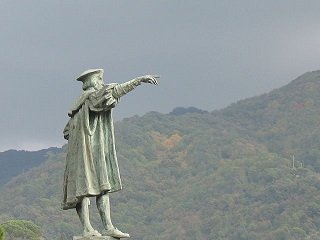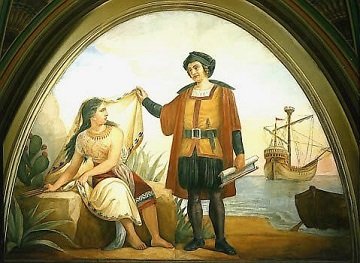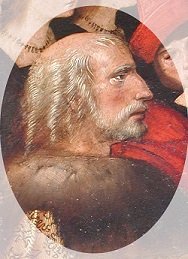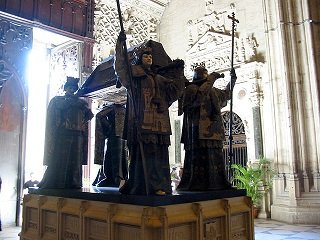Christopher Columbus, Explorer and Governor

Cristoforo Colombo, known to us as Christopher Columbus, was born in the city-state of Genoa in 1451. [1] Genoa had been part of the Kingdom of Italy when the Holy Roman Empire held dominion over the territory, and had gained its independence, along with the other Italian city-states of the period, when the empire’s power waned. By the time of Columbus’ birth Genoa’s power was on the decline – their territories in the Middle East, gained during the Crusades, had been conquered by the Ottoman Empire while they themselves were under the dominion of Milan. The Colombo family were middle class – his father Domenico worked primarily as a wool weaver and dealer, though he also had business interests in a cheese stand. The Genoan style tended towards diversity and enterprise, and Domenico was no exception. He lacked the drive to prosper, but he was popular. Still, he had little to leave his three sons and they knew they would have to make their own ways. For two of them, Christoforo and Bartolomeo, that path led to the sea.
The exact course of Columbus’ early career is hard to chart, but he seems to have found his niche in the trading fleets that Genoa was famous for, and sailed the Mediterranean for six years. There are reports that he was shipwrecked off the coast of Portugal in 1476 and that this began his association with the Iberian Peninsula. He definitely settled in this area around this time, though he also took a voyage north to Iceland transporting an unknown, but valuable, cargo. On this journey he docked in both Bristol and Galway. He would later note that he had heard stories of bodies “of extraordinary appearance” being washed ashore in Ireland from the west (possibly Inuit fishermen). While he never made mention of it, it’s also certainly plausible that he heard stories from the Icelanders of the journeys west of Leif Erikson five hundred years earlier.

In 1479 he married Filipa Moniz Perestrelo, a Portuguese women of noble but impoverished stock. Quite how a commoner like Columbus managed to marry a noble remains a matter of scholarly debate, though the simplest explanation is simply that he had money, which her family needed, and that Filipa was, at 25, rapidly aging off the marriage market. As Filipa was, by birth, a member of the Order of Santiago, her marriage required the assent of the head of her order – King John II. This royal connection may have been what got Columbus into the African trade that the Portuguese had a solid hold on at this time. Over the next five years he traded in Africa while Filipa gave him a son, Diego. In 1484 he presented his famous plan to King John II – to reach the East Indies by sailing west, around the globe.
It’s a common misconception that the reason Columbus had problems getting people to accept his idea to shortcut around the globe to the Indies was because they believed the world was flat. (A sea passage was needed as the Islamic states of the Middle East had closed off the traditional land routes.) In fact, the vast majority of the educated world knew the world was round, and it was in fact part of the official Church-endorsed Platonic view of the universe. The reason he had problems was because the majority of those scholars had a much better idea than he did of the actual size of the Earth. By their numbers the distance he would need to sail west (equivalent to the width of the Atlantic and Pacific oceans combined) was unattainable. [2] Columbus, perhaps buoyed by tales he had heard in Iceland, was convinced it could be done. King John II had other plans. His fleets explorations down the western coast of Africa were showing great promise, and in fact four years later they would round the Cape of Good Hope and find the southern passage to the Indies. Against that Columbus’ long shot seemed not worth pursuing.

Columbus left Portugal in 1485. His Portuguese wife disappears from view around now – either her death was what prompted him to leave or he simply abandoned her. There are some accounts that she entered a convent, and died in 1506. In Spain Columbus tried to present his plan to the royal court, but with no success. He did find a replacement paramour in 1487 – a 20 year old woman named Beatriz Enríquez de Arana. Though the two had a son, and she wound up becoming a mother to young Diego as well, Columbus never married her. It’s possible that he hoped to marry into Spanish nobility, as he had in Portugal, in order to further his career.
For the next five years Columbus continued to try to present his plan to King Ferdinand II and Queen Isabella I. Though they refused to commit funding, they found his ideas intriguing enough to pay him not to leave their court. Finally in 1492, possibly driven by their rivalry with Portugal and hopes to shortcircuit their trade network, the royal couple gave their assent. In April 1492 they drew up an agreement to fund an expedition. Four months later Columbus set out on his famous journey.

In August 1492 Columbus sailed south with three ships (the Santa Maria, the Nina and the Pinta) to the Canary Islands, where he refilled his supplies and then set off due west. He believed (erroneously) that this would put him on a direct course for Japan, though he did also believe that other islands might lie between them. After five weeks of sailing a lookout on the Pinta spied land, though Columbus would later claim that he himself had already spied a light in the distance the night before. (This meant that he was entitled to the bounty promised to the first person to spy landfall.) As he had expected, he had reached an archipelago of islands – what we nowadays know as the Bahamas.
Columbus spent three months exploring these islands, heading south to Cuba and Hispaniola. He noted with delight both the gold ornaments that the natives wore, and their lack of any notable military prowess.
Thursday 11th October: “Weapons they have none, nor are acquainted with them, for I showed them swords which they grasped by the blades, and cut themselves through ignorance. They have no iron, their javelins being without it, and nothing more than sticks.”
Sunday 14th October: “I could conquer the whole of them with 50 men, and govern them as I pleased.”
Though the tone of his entries makes this seem like mere idle speculation, it would soon turn out to be anything but. In fact, on his first journey, with one notable exception, Columbus had a peaceful relationship with the natives, and left behind 39 men who were to establish a permanent colony. This exception was his final encounter, an attempt to trade for supplies with the Ciguayo people that resulted in the Spanish being chased off the beach under fire from arrows. They did take about two dozen natives prisoner however, and transported them back to Spain with them (though only a third survived the trip). For the return journey Columbus took the gamble of sailing north and trying to catch the west winds he knew blew across the north Atlantic. The gamble paid off and the winds brought him almost directly home to Europe.

On his way back to Spain Columbus stopped off in Portugal – probably due to bad weather, though he may have wished to rub the King of Portugal’s nose in his success. If the latter, it was a risky gamble – there were factions in the Portuguese court who made noises about killing him, though reportedly King John II blocked this. Instead, the two men spoke, and John made it clear that if Columbus had found Indian islands, then by a pre-existing papal treaty he planned to claim them. (It was this that would lead to the later division of South America and see Brazil ceded to Portugal.) Columbus left Portugal and returned to Spain on the 15th March, creating a sensation. It seems likely that the Spanish court had expected him never to return.
Six months later Columbus set out again, this time with seventeen ships and between twelve and fifteen hundred men – not just sailors, but farmers and soldiers to establish a permanent colony. (And, of course, priests both to serve the colony and to convert the natives.) Along with him sailed a childhood friend, Michele da Cuneo, who documented the trip in his journal. (Da Cuneo was a nasty piece of work,and in his writing he boasts of beating a native servant that Columbus gave him into submission before raping her.) Though Columbus set off from the same point, his course veered south and he made landfall in the Antilles, a chain of islands named for a western land of Spanish myth. From here he sailed north, visiting Puerto Rico and once again going along the coast of Cuba and Hispanolia. The men he had left behind were dead – presumably killed in a native attack – and the fort they had built was destroyed. A hundred miles further along the coast Columbus founded a new colony, naming it La Isabella after the Queen. In February a group of twelve ships returned to Spain with gold, spices, slaves and parrots, which had become a popular pet among the colonists. They also brought the first criticisms of Columbus to the Spanish monarchs.

Unaware of the rumblings against him in Spain, Columbus organised retaliatory strikes against the natives. He sought out the source of the gold the natives had, while charting the coastline. Against the evidence he decided that Cuba was actually the Chinese mainland, and that Hispanolia (where he concentrated his efforts) was the land referred to in the Bible as Sheba. In 1495 he began a determined campaign of conquest against the natives. Wild stories circulated about his conduct at this time, and it’s impossible to separate fact from fiction. We know from his own diaries that women were trafficked back to the main colony as slaves, with Columbus writing:
“A hundred castellanos are as easily obtained for a woman as for a farm, and there are plenty of dealers who go about looking for girls; those from nine to ten are now in demand, and for all ages a good price must be paid.”
More grisly tales had it that he imposed a quota of gold dust to be paid be each native, and took the hands from those who did not meet the quota. (A tactic notably used by Belgians in the Congo four centuries later.) The most outrageous, and least believable, tale was that he and his men fed the natives to their dogs.
In 1496 Columbus returned to Spain, and to two disappointed monarchs. Though his journey had made a return, it had fallen far short of what he had promised. None of them really understood what he had actually found. Still, a papal treaty had given them the right to the new lands and so they sent him back with provisions for the colony and more men. His orders were to explore to the south – to find the passage to India that should be there if his theories were correct. On the journey back Columbus verified his observations on the variation between magnetic north (as shown by the needle on a compass) and geographic north (as shown by the Pole Star), thus laying the foundation for the measurement of longitude. Once there he explored in search of the passage, but without luck. He did, however, reach the coast of South America and so the American continent for the first time, where the great size of the Orinoco river told him that this was no island. As he tracked along the coast (in search of King Solomon’s gold mines, of course) he fell ill, and so his ships headed north back to Hispaniola.

Once he arrived at the island Columbus found it in chaos – the natives were fighting back while the settlers, upset at the conditions on the island, were in revolt. His younger brother Bartholomew had not helped matters by imposing a much more forceful gold collection regime. While Columbus did his best to reimpose order (through a liberal dispensation of the death penalty, among other tools) a messenger was already en route from Spain. It did not bring, as Columbus had requested, a royal commissioner to help him govern but rather it had orders for his arrest. In late 1500 he and his brothers were brought back to Spain in chains. During the journey Columbus wrote a letter to their majesties detailing his discoveries, and propounding his theories about them. The most outlandish of these was that this new continent represented the edge of Paradise itself. Spiritual meanderings aside, it remains one of the best accounts of his journeys (though hardly impartial, of course) and it won him his freedom. After an audience the two monarchs agreed to give him the ships for one last voyage of exploration – though they did replace him as Governor of the new colony.
In May 1502 Columbus set out on his last journey. He was under explicit orders to investigate the land to the south and to avoid Hispanolia – orders he immediately ignored. The new governor, Nicolás de Ovando, closed the port to him and he was forced to sail off. He headed west, mapping Jamaica and improving his charts of Cuba, and then went south to Honduras. From here he sailed west along the coast, seeking the strait that would allow passage, he thought, to India. Though this proved non-existent he did find native merchants. After two months a ferocious storm off Panama halted his progress, and he explored inland (sailing upriver) for a while before setting off back to Hispanolia. Another storm damaged his ships further and he was forced to make landfall in Jamaica in June 1503.
At first Columbus was optimistic, and he sent men to Hispanolia requesting rescue. Rescue was a long time coming, however, and it was a full year later before Ovando bothered to send help. He may not have expected to find Columbus alive – however the admiral had managed to convince the natives he was a powerful sorcerer by predicting a lunar eclipse (using his almanac), and so they had kept him supplied. Still, he had more sense to hang around in Hispanolia and by November he had returned to Spain. There he found that the monarch who had always been most sympathetic to him, Isabella, was dying.

Columbus spent his final years hounding the King for the money owed to him by their initial agreement, though in truth he was well off with what he had. His son Diego was also a powerful figure in the court, and well able to provide for himself. Columbus’ health never recovered from the illness he suffered on his third voyage (now thought to be a form of arthritis brought on by malnutrition) and in 1506, aged only 54, he died. He was originally buried in Spain, but in 1542 they were moved to Hispanolia. When France took over Hispanolia in 1795 they were moved to Cuba, though by some accounts some were left behind and rediscovered in 1877. The main bones were returned to Spain in 1898. Though the bones in Santa Domingo have never been authenticated, it seems poetic to think that the man who opened up one world to another should have wound up buried in both.
Images via wikimedia.
[1] There are fringe theories that he was actually Catalan, Polish, Portugese and, most bizarrely, Scottish. However for the sake of simplicity we shall stick to the mainstream history.
[2] The distance Columbus estimated he would have to sail was 2300 miles. The actual distance he would have had to sail (if the Americas had no been in the way) is over three times that – around 7800 miles.
